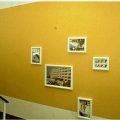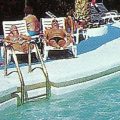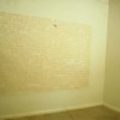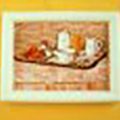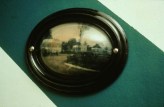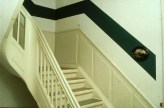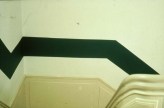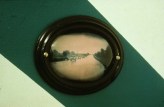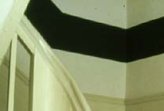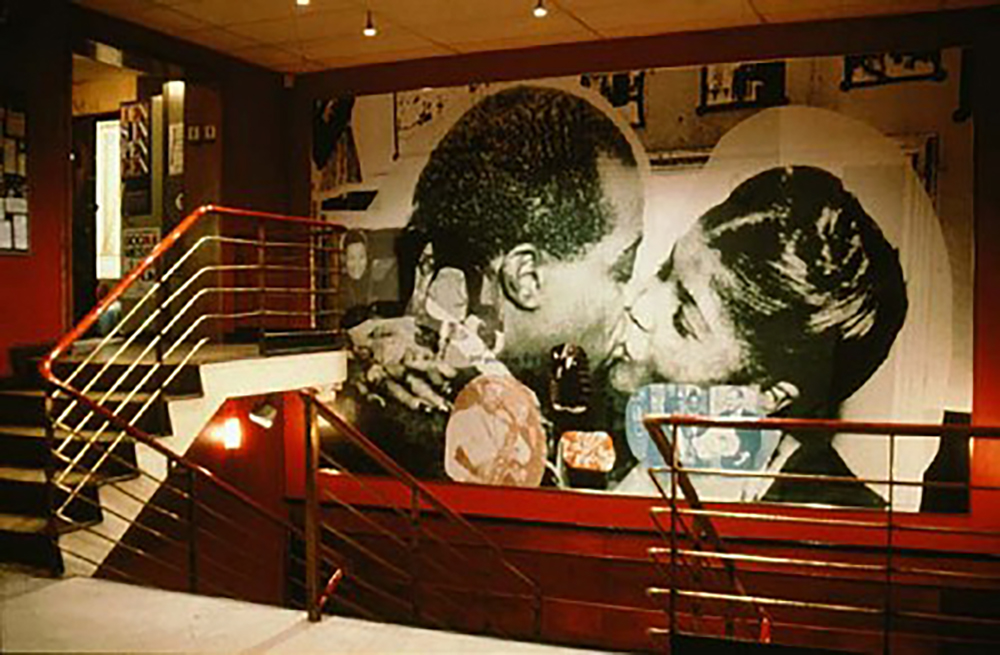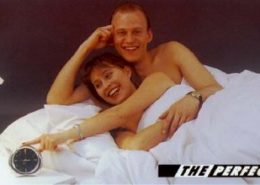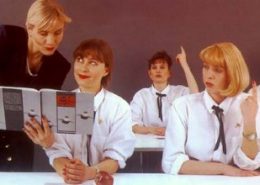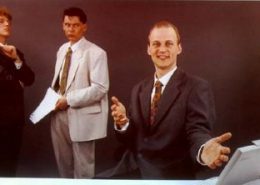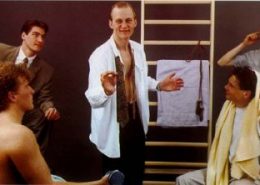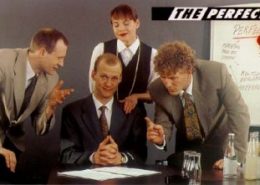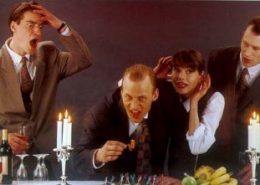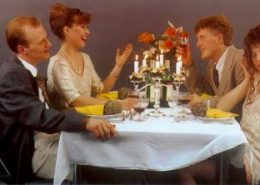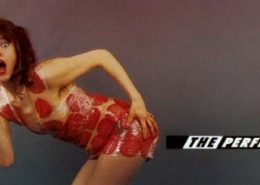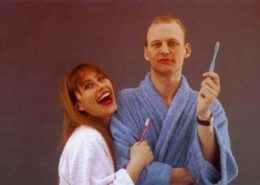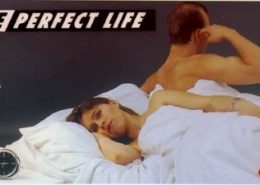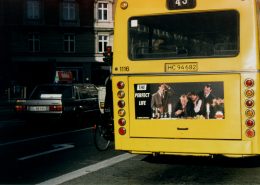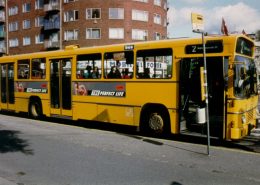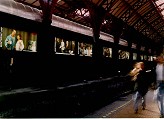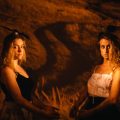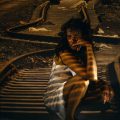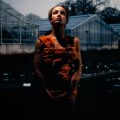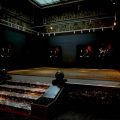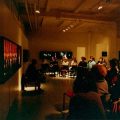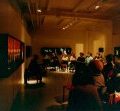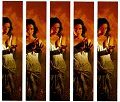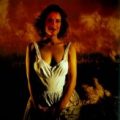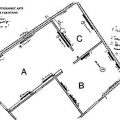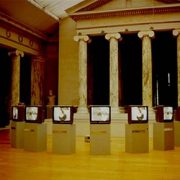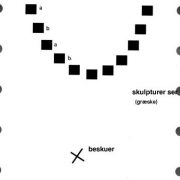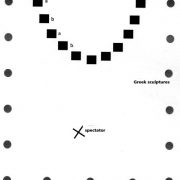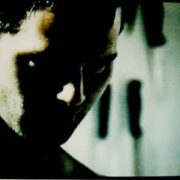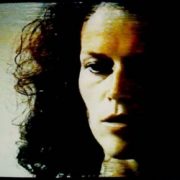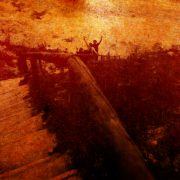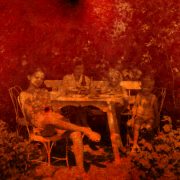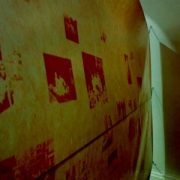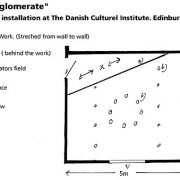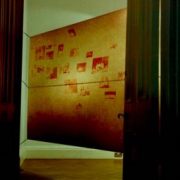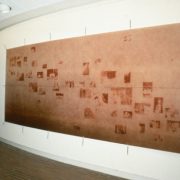Mumies – Erlier erlier Works
Sofa Pictures – an insight into the private sphere
The Vision”Sofa Pictures” is a place-specific work, which through a twisting of the concept “the sofa picture today” says more about us and our lives in the 90s.
– a work; the precision of many meanings
The motifs for the exhibition “Sofa Pictures” are taken from the “dream pictures” (the luxury pictures) of our lives: hotel rooms, by the swimming-pool, at a restaurant from travel brochures and the like.
– But by magnifying the details from these “public” pictures we find that the motif reveals other details than the first colourful, inviting and at the same time anonymous pictures. A strange oppressive emptiness appears in the picture – an alluring privateness appears in the pictures, for example in the body language of the picture “Woman With her Back Turned” (enclosed), and when one comes closer to examine the picture, it dissolves into spots of colour….
It as if the picture contains something of that…which means the very most…. but nevertheless remains silent for the observer.
The sofa picture is a “surplus” we hang on the wall to please the eye – seen from the sofa / together with the picture.
The sofa is the sphere of the private: “security”, “rest”, and “coziness”. A sofa voter does not vote, but takes things as they come. Sofa and home are closely associated – feeling at home is about a sense of belonging in the world.
The place: The place is Gallery . The physical and psychic space of the gallery form part of the work. The installation has primarily something to say about the sphere of the gallery. The gallery, which traditionally sells art in smallish format (sofa pictures), art as objects for collection – by private persons.
The collector: To collect art is actually to collect the feelings/experiences of other people? = A sofa picture is a piece of materialised life!
A text wall centered in the space circles in fragments (quotations) around the points of everyday life and the pain and the passion in life.
As if what she was
silent about was not
what mattered most
As if she was only a wretched sieve
daily life ran through (Pia Juhl)
InBetween
InBetween was exhibited at Kulturhuset, Copenhagen and the North Jutland Museum of Art in 1993. INBETWEEN consists of a green stripe of colour along a stairway and two objects hung at the top and bottom of the stairs respectively.
The objects consist of a photograph mounted in a glass bubble and an apparently old frame. The glass bubble produces a concave mirror effect (for seeing round corners) or it may remind you of the glass bubbles with snow in them that you bring home from a holiday.
The photograph at the bottom of the stairs is taken through the rear window of a car with a view of a line of caravans. The photograph at the top taken through the windscreen of a car shows an unending road filled with cars driving in the opposite direction.
The objects constitute their own world both in the little glass bubble and in the inner world of the caravan. Just as the stairway where they are hung is characterized by being a place where you move from one platform to another, so the objects bear associations with movement and attempts at permanence.
The frame, pictures and the souvenir are an attempt at recollecting vanished experiences, the caravan is the placeless home and the car is the symbol of modern man’s mobility. The motifs make up a multiplicity of references in perpetual movement and can thus be seen as a picture of art.
The philosopher Martin Heidegger regards art as a home where people can settle in and find shelter. In Lisa Rosenmeier’s INBETWEEN the green stripe links the two platforms making the intervening space a place, while the motifs of the objects represent a space in space – and an inbetween past and future.
INBETWEEN uses the stairway as a passage between two levels and transforms it from transition into place a platform in itself.
With the objects hung by the stairway INBETWEEN is an installation that both relates to the role of art as a reflectional interspace of platforms in our everyday lives, allowing this inbetween to involve the viewer and the place the exhibition as part of the work.
Off-picture no. 119
A work for a landing in Copenhagen Jazzhouse
A picture – executed with point of departure in the place (Jazzhouse) and proportioned to the space and the space’s existing image (colours, interior and function). “OFF-PICTURE no. 119 attempts to combine the physical and psychicessence of the place in the work on the wall.
The Space
The place houses performances of innovative and experimental jazz. It was therefore natural to take the images of jazz as a starting-point for the work.
The wall is an end wall on a landing, which can be seen from any point on the top floor of the building.
A 102 cm high panel gives one the impression that the wall was formerly decorated with a theatrical painting.
The wall also gives associations of collage and a place for pinning up cuttings, which fits in with the general image of the place. The place is part of a staircase – a landing, a pause between two floors and “a smokers’ precinct” in the break between two sequences of music. I have therefore chosen to work with interval pictures from jazz, pictures taken in, for instance, the dressing room, a kiss between lovers in the interval or the family being waved goodbye to, etc.
Comments
The physical space gained from a continuation of the red colour (from the side walls) as a background for a large unifying work on the end wall and from highlighting the proportions of the space and the staircase by hanging 12 copper lamps in the style of the place above the stairs – one for each slat in the banisters. Because of the size of the work, the function of the place as a discotheque and the placing of the work (people lean against it with beer and cigarettes in their hands) it was necessary to execute the work in a laminate (non-inflammable and washable).
To bring laminate into a space overlaid by the patina of years requires a material that has body. I have therefore chosen to work with pictures in a “transparent layer technique” so that the underlying shining through give sensuous life to the dead laminate.
Jazz often seems to move on a number of levels that barely seem connected. I have tried to let this knowledge permeate my composition.
In the composition itself, however, the utmost regard had to be paid to the proportions of the room. For instance, it was necessary somehow or other to gather the arch of the stairs above the work and the surrounding colours within the work itself. (White ceiling, yellowy terrazzo floor, red and green walls, etc.) The composition requires some huge leaps, as one sees it both at an incredibly big distance and from 15 cm – and at the same time it has to be so calm that drunks don’t fall down the stairs at the sight of it!
Which is why it became OFF-PICTURE no. 119.
The Perfect Life
THE PERFECT LIFE is a fictive advertising campaign consisting of a series of 12 pictures that were shown at various locations in the public space in the period August 1992 to September 1993: – illuminated montres at Copenhagen Central Station and Aarhus Central Station – streamers on Copenhagen buses – advertisements in the two newspapers Weekendavisen and Politiken. – three different post cards distributed free across the country. The pictures appear at first sight to be lifestyle advertising photographs with recognizable texts and motifs. Closer examination reveals that neither text nor picture reveal who the sender is. Formally they resemble adverts, but in order to achieve a full understanding it is necessary to carry out the kind of close reading usually reserved for works of art.
The statements made by the photographs in THE PERFECT LIFE function as the works message and place a spotlight on the lifesyle offered to us in advertising pictures and thereby on the state of Western culture – now in an easily accessible visual form.
THE PERFECT LIFE is a project that challenges the borderline between experimental visual art and advertising. Just as the visual arts reflect surrounding society and its modes of communication, many of the major advertising campaigns in recent years have clearly borrowed elements from the visual arts. Implicit messages and ambiguous pictures have become an important component of the more avant-garde advertising campaigns for the lifestyle products that advertisers are seeking to give a central place in modern patterns of consumption. Advertisements both reflect and create our dreams, and they therefore play a key role in shaping our lives.
THE PERFECT LIFE raises questions regarding the use of commercial visual effects in public space. The closing of the gap between the visual arts and advertising has created a situation in which pictures (whether they are art or advertising) derive from a symbiotic relationship between the two, as a result of which pictures are exchanged and assume meaning more in terms of who is presenting them and why than in terms of what they represent.
Suitcase
SUIT-CASE is a book work containing a series of photographic allegories. But SUIT-CASE is also a spatial experience in the form of a number of selected photographs in illuminated montres shown at four museums in Denmark in 1993 Ð94: The New Carlsberg Glyptotek, Copenhagen, the Museum of Photography, Odense, the Horsens Art Museum and the Museum of Modern and Contemporary Art, Aalborg.
The SUIT-CASE book consists of 30 cases. A suitcase is not only something you take along on a trip, suit also means fitting, appropriate, while case is a matter of interest or concern and cases en suite are cases one after another. The title refers to the way the photographs are put together in the book – 30 different cases that appear as states of things presented in succession – but also to the individual cases and their placing on the open page, where the space between also has an important function in relation to the total composition.
The pictures consist of one or more persons staged in front of a magnified projection of familiar holiday motifs. A recurring feature is that the bodies are used as gesture in the experience of a state. On cursory inspection the pictures resemble those of the modern media culture, but their seriality and the individual cases open up for other readings. The staged photographs and the slides appropriated from everyday life bring about a transposition of reality and place SUIT-CASE in the interspace between a real and a staged reality leaving the viewer to decide which is the most real.
Circum 6
“Circum 6”: a video installation consisting of “7 statements”, cut to form a mosaic of image and sound and edited onto two video tapes which are distributed among 11 screens in variety of sequences. “Circum 6” was created in 1988 for the ceremonial hall of the Ny Carlsberg Glyptotek in Copenhagen.
Conglomerate
The skin makes up the borderline between the outer and the inner world. Today we live in a total simulacrum culture, in which the skin and body are the only places we can feel a difference.
DESIRE, Gender, body and attraction
The work is about women’s history and about personal history and it is placed in a museum that functions as a spiritual treasure house of our time. Women’s time in the world of art has not been long, except as a model and muse for the male artist. The history of women is tied to the family space.
A exhibition like this is a place where one looks back and across to other cultures in order to make the culture in which we find ourselves more visible. By placing pictures from a personal album a “different” cultural history can be drawn, one which contributes largely to the writing of the official history of art.
The family photographs are like “brands” on the skin; because it is the body that absorbs our memories…
The pictures are not arranged in a time-line, but more as a cross-section of a turbulence.
The skin makes up the borderline between the outer and the inner world. Today we live in a total simulacrum culture, in which the skin and body are the only places we can feel a difference.
The skin is thin and extended like paper….a life that is only skin deep?
The work measures 180 x 450 cm.
1995

